Economics: Critically Assess Causes of UK Inflation (July-Aug 2018)
VerifiedAdded on 2023/04/24
|10
|2112
|335
Essay
AI Summary
This economics essay critically examines the causes of inflation, with a particular focus on the rise in inflation within the UK economy between July and August 2018. It begins by defining inflation and differentiating between demand-pull and cost-push inflation. The essay then provides an overview of the UK's inflation trend during the specified period, highlighting the key contributors to the increase in the consumer price index (CPI), including recreation, culture, transport, clothing, and footwear. Furthermore, the essay investigates the impact of Brexit and the depreciation of the pound on inflation, discussing the concept of imported inflation. It also delves into the concept of cost-push inflation in the UK, caused by rising raw material and oil prices. Finally, the essay explores the Bank of England's monetary policy responses, such as interest rate adjustments, aimed at controlling inflation and maintaining price stability. The essay concludes by summarizing the key factors contributing to the inflationary trend in the UK during the period analyzed.
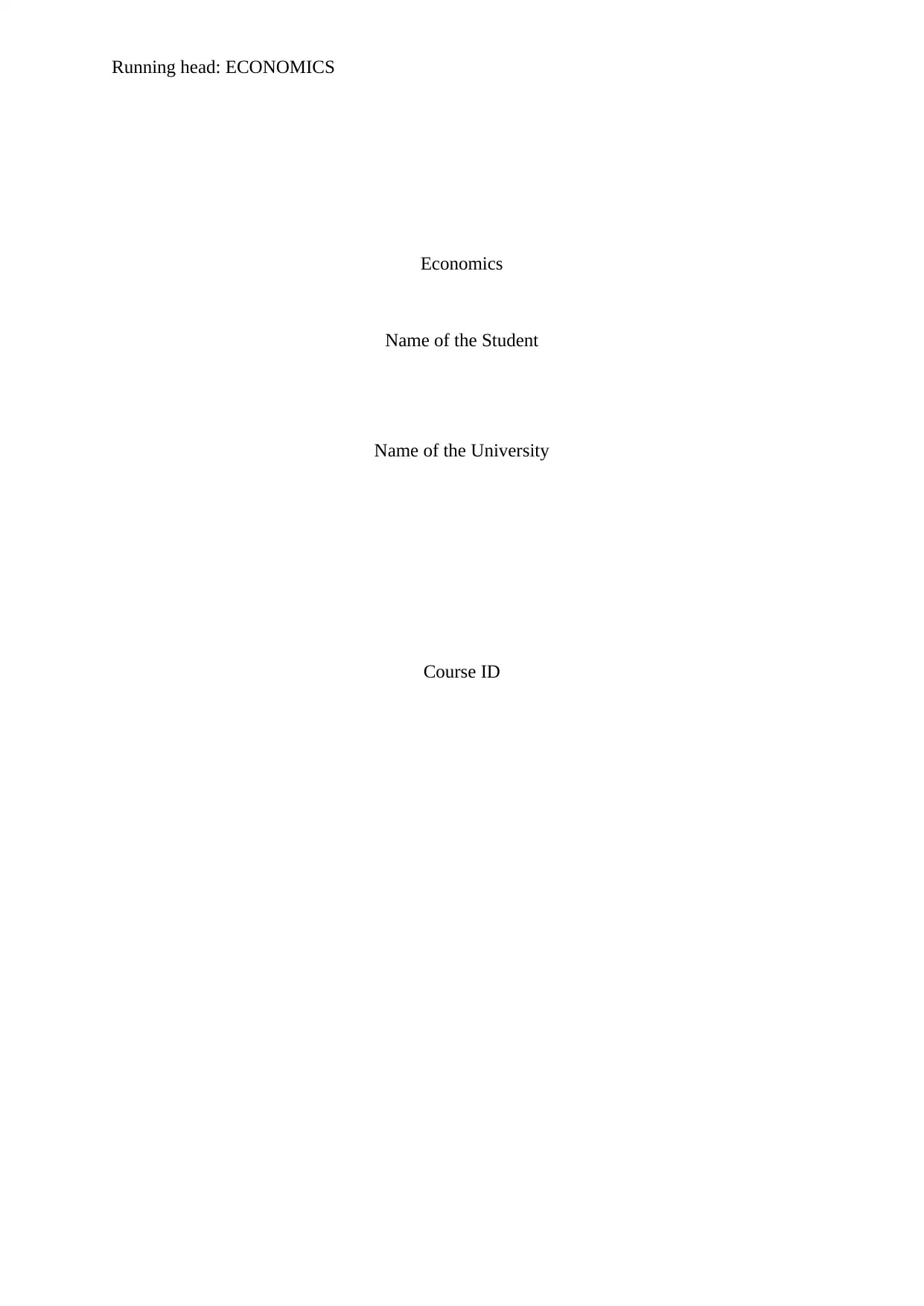
Running head: ECONOMICS
Economics
Name of the Student
Name of the University
Course ID
Economics
Name of the Student
Name of the University
Course ID
Paraphrase This Document
Need a fresh take? Get an instant paraphrase of this document with our AI Paraphraser
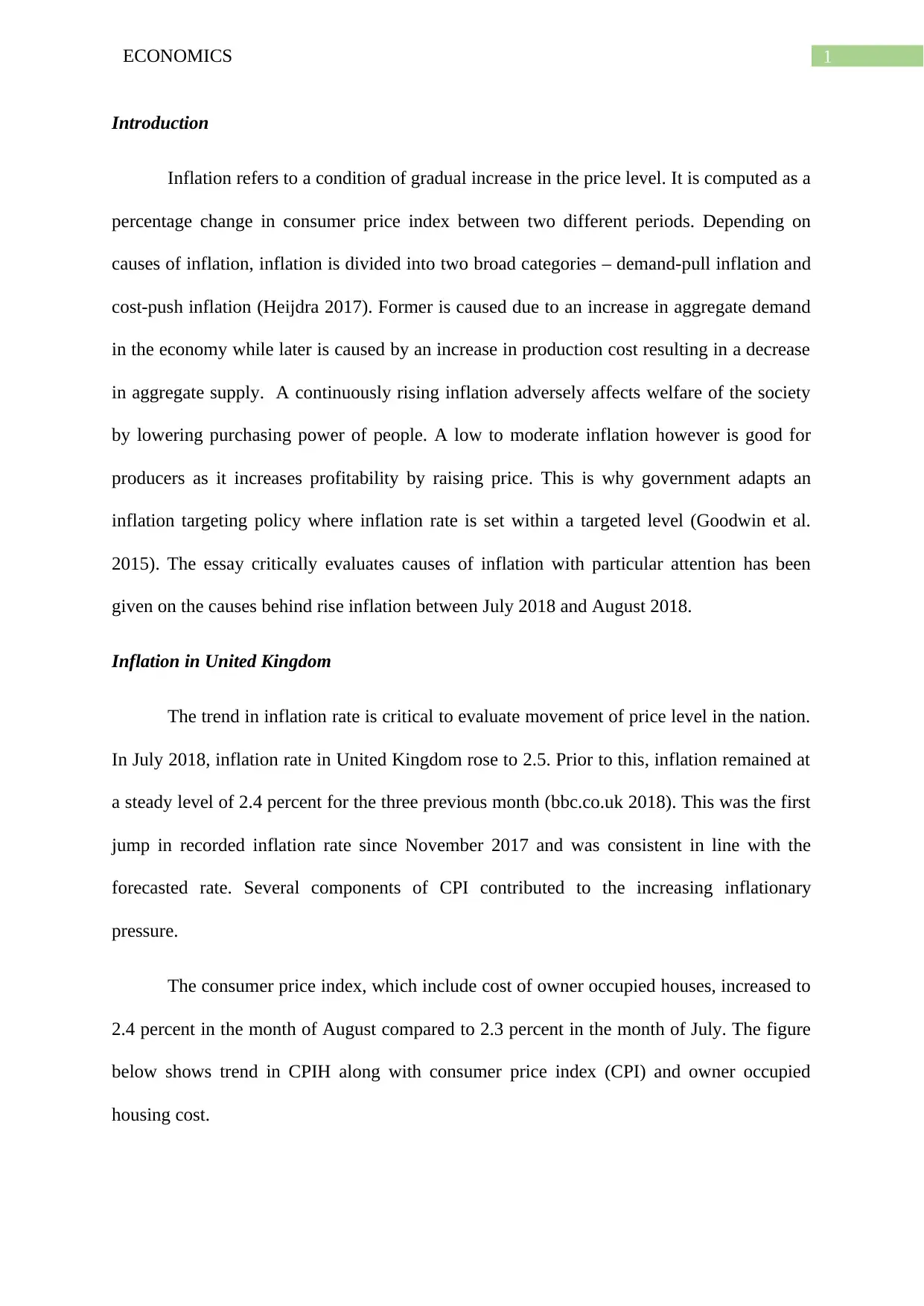
1ECONOMICS
Introduction
Inflation refers to a condition of gradual increase in the price level. It is computed as a
percentage change in consumer price index between two different periods. Depending on
causes of inflation, inflation is divided into two broad categories – demand-pull inflation and
cost-push inflation (Heijdra 2017). Former is caused due to an increase in aggregate demand
in the economy while later is caused by an increase in production cost resulting in a decrease
in aggregate supply. A continuously rising inflation adversely affects welfare of the society
by lowering purchasing power of people. A low to moderate inflation however is good for
producers as it increases profitability by raising price. This is why government adapts an
inflation targeting policy where inflation rate is set within a targeted level (Goodwin et al.
2015). The essay critically evaluates causes of inflation with particular attention has been
given on the causes behind rise inflation between July 2018 and August 2018.
Inflation in United Kingdom
The trend in inflation rate is critical to evaluate movement of price level in the nation.
In July 2018, inflation rate in United Kingdom rose to 2.5. Prior to this, inflation remained at
a steady level of 2.4 percent for the three previous month (bbc.co.uk 2018). This was the first
jump in recorded inflation rate since November 2017 and was consistent in line with the
forecasted rate. Several components of CPI contributed to the increasing inflationary
pressure.
The consumer price index, which include cost of owner occupied houses, increased to
2.4 percent in the month of August compared to 2.3 percent in the month of July. The figure
below shows trend in CPIH along with consumer price index (CPI) and owner occupied
housing cost.
Introduction
Inflation refers to a condition of gradual increase in the price level. It is computed as a
percentage change in consumer price index between two different periods. Depending on
causes of inflation, inflation is divided into two broad categories – demand-pull inflation and
cost-push inflation (Heijdra 2017). Former is caused due to an increase in aggregate demand
in the economy while later is caused by an increase in production cost resulting in a decrease
in aggregate supply. A continuously rising inflation adversely affects welfare of the society
by lowering purchasing power of people. A low to moderate inflation however is good for
producers as it increases profitability by raising price. This is why government adapts an
inflation targeting policy where inflation rate is set within a targeted level (Goodwin et al.
2015). The essay critically evaluates causes of inflation with particular attention has been
given on the causes behind rise inflation between July 2018 and August 2018.
Inflation in United Kingdom
The trend in inflation rate is critical to evaluate movement of price level in the nation.
In July 2018, inflation rate in United Kingdom rose to 2.5. Prior to this, inflation remained at
a steady level of 2.4 percent for the three previous month (bbc.co.uk 2018). This was the first
jump in recorded inflation rate since November 2017 and was consistent in line with the
forecasted rate. Several components of CPI contributed to the increasing inflationary
pressure.
The consumer price index, which include cost of owner occupied houses, increased to
2.4 percent in the month of August compared to 2.3 percent in the month of July. The figure
below shows trend in CPIH along with consumer price index (CPI) and owner occupied
housing cost.
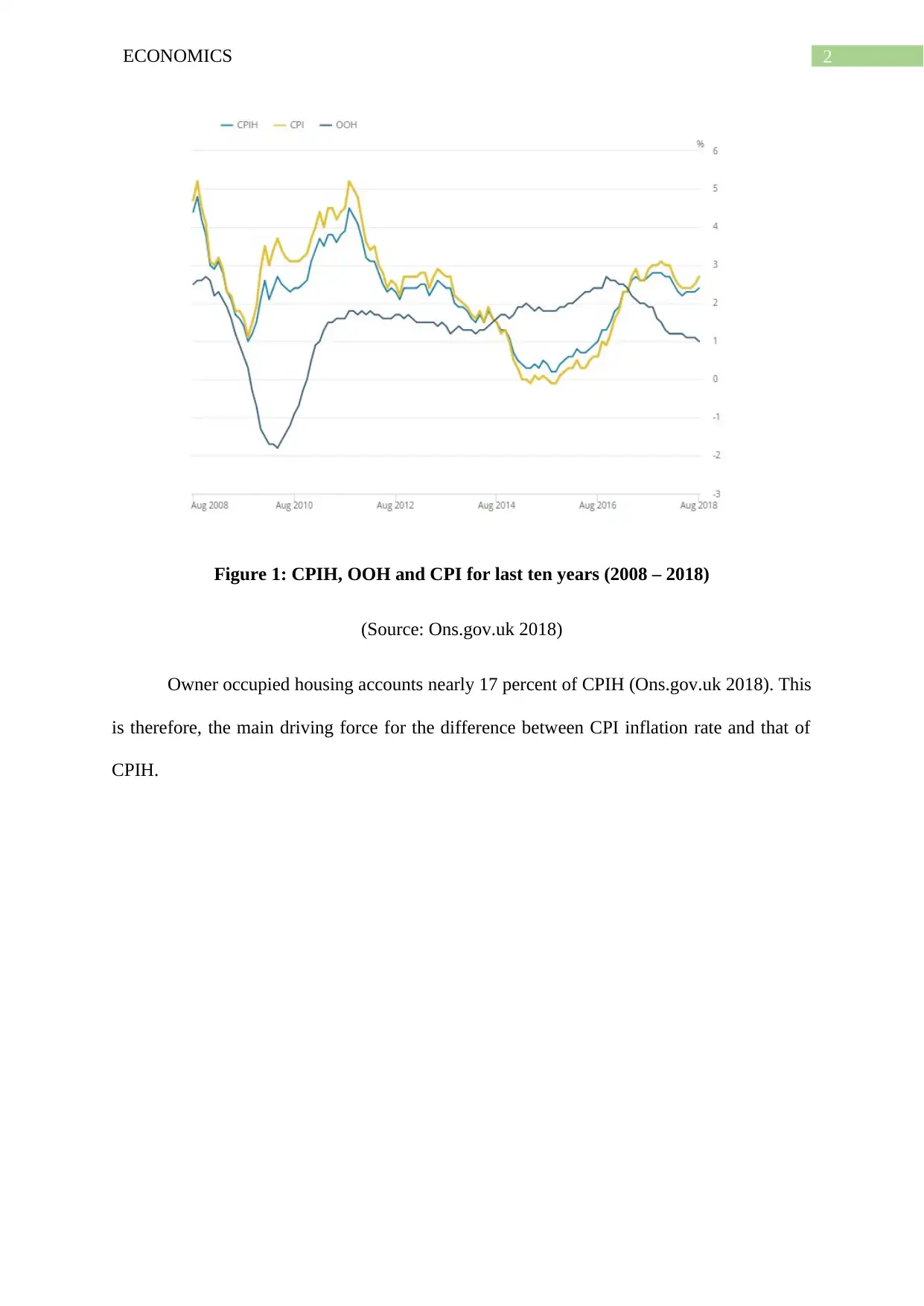
2ECONOMICS
Figure 1: CPIH, OOH and CPI for last ten years (2008 – 2018)
(Source: Ons.gov.uk 2018)
Owner occupied housing accounts nearly 17 percent of CPIH (Ons.gov.uk 2018). This
is therefore, the main driving force for the difference between CPI inflation rate and that of
CPIH.
Figure 1: CPIH, OOH and CPI for last ten years (2008 – 2018)
(Source: Ons.gov.uk 2018)
Owner occupied housing accounts nearly 17 percent of CPIH (Ons.gov.uk 2018). This
is therefore, the main driving force for the difference between CPI inflation rate and that of
CPIH.
⊘ This is a preview!⊘
Do you want full access?
Subscribe today to unlock all pages.

Trusted by 1+ million students worldwide

3ECONOMICS
Figure 2: Different contributors of CPI inflation
(Source: Ons.gov.uk 2018)
Figure 2 shows broad categories of goods and services having an upward pressure on
consumer price index as recorded in August 2018. The biggest contributor of CPI inflation in
UK between July 2018 and August 2018 was recreation and culture category. Price for this
category increased by 0.6 percent. The main impact has been come from the category of
cultural service (Melolinna and Toth 2019). The price of theatre admission rose significantly
along with an increase in price of computer games. Price of these games are subject to
composition of best sellers’ chart that often changes from one month to another.
Transport also constituted an upward pressure on overall price level. The transport
fares for passengers showed the biggest increase in prices between July 2018 and August
2018. Transport fares increased because of increases in sea and airfares. A downward trend
Figure 2: Different contributors of CPI inflation
(Source: Ons.gov.uk 2018)
Figure 2 shows broad categories of goods and services having an upward pressure on
consumer price index as recorded in August 2018. The biggest contributor of CPI inflation in
UK between July 2018 and August 2018 was recreation and culture category. Price for this
category increased by 0.6 percent. The main impact has been come from the category of
cultural service (Melolinna and Toth 2019). The price of theatre admission rose significantly
along with an increase in price of computer games. Price of these games are subject to
composition of best sellers’ chart that often changes from one month to another.
Transport also constituted an upward pressure on overall price level. The transport
fares for passengers showed the biggest increase in prices between July 2018 and August
2018. Transport fares increased because of increases in sea and airfares. A downward trend
Paraphrase This Document
Need a fresh take? Get an instant paraphrase of this document with our AI Paraphraser
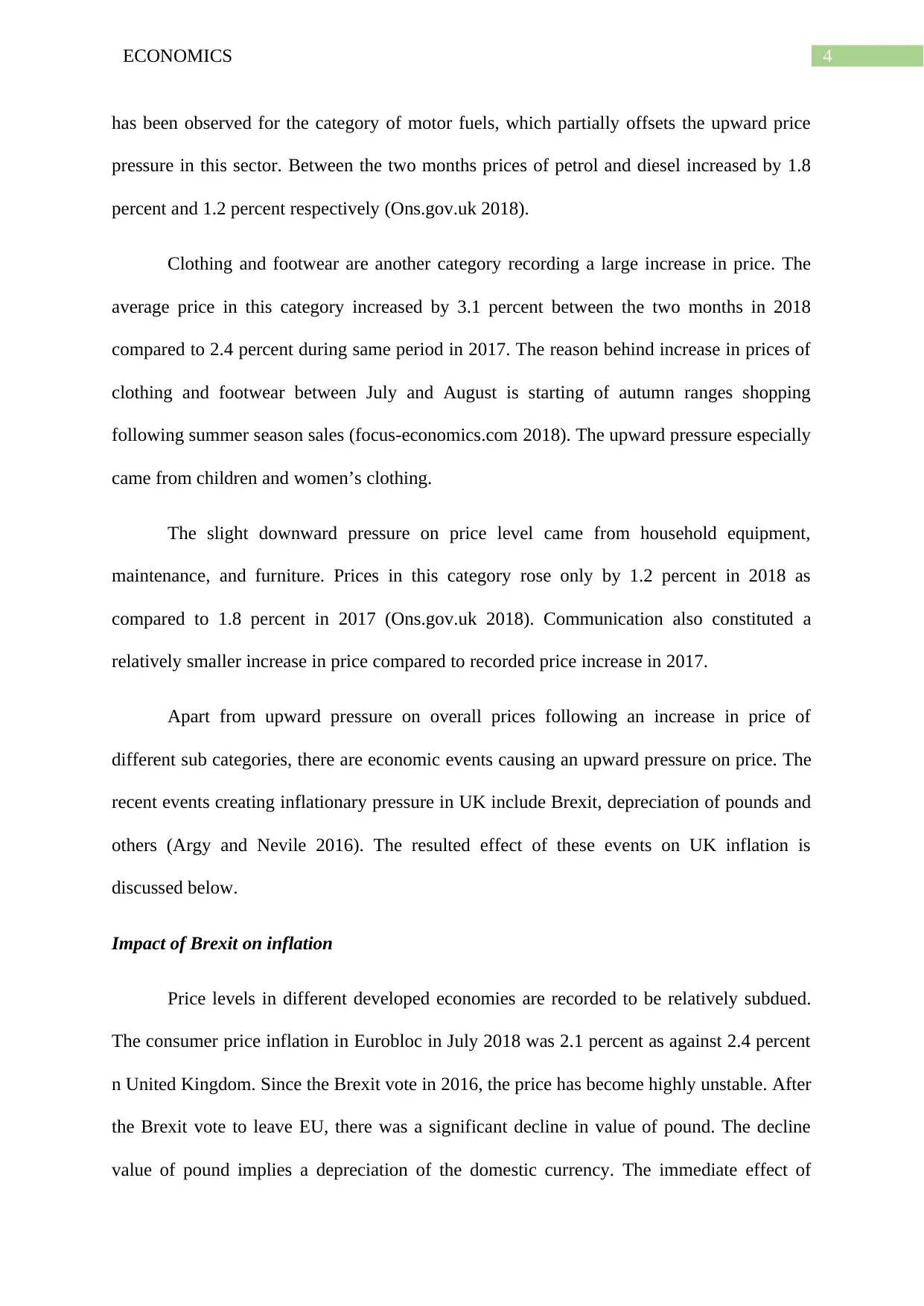
4ECONOMICS
has been observed for the category of motor fuels, which partially offsets the upward price
pressure in this sector. Between the two months prices of petrol and diesel increased by 1.8
percent and 1.2 percent respectively (Ons.gov.uk 2018).
Clothing and footwear are another category recording a large increase in price. The
average price in this category increased by 3.1 percent between the two months in 2018
compared to 2.4 percent during same period in 2017. The reason behind increase in prices of
clothing and footwear between July and August is starting of autumn ranges shopping
following summer season sales (focus-economics.com 2018). The upward pressure especially
came from children and women’s clothing.
The slight downward pressure on price level came from household equipment,
maintenance, and furniture. Prices in this category rose only by 1.2 percent in 2018 as
compared to 1.8 percent in 2017 (Ons.gov.uk 2018). Communication also constituted a
relatively smaller increase in price compared to recorded price increase in 2017.
Apart from upward pressure on overall prices following an increase in price of
different sub categories, there are economic events causing an upward pressure on price. The
recent events creating inflationary pressure in UK include Brexit, depreciation of pounds and
others (Argy and Nevile 2016). The resulted effect of these events on UK inflation is
discussed below.
Impact of Brexit on inflation
Price levels in different developed economies are recorded to be relatively subdued.
The consumer price inflation in Eurobloc in July 2018 was 2.1 percent as against 2.4 percent
n United Kingdom. Since the Brexit vote in 2016, the price has become highly unstable. After
the Brexit vote to leave EU, there was a significant decline in value of pound. The decline
value of pound implies a depreciation of the domestic currency. The immediate effect of
has been observed for the category of motor fuels, which partially offsets the upward price
pressure in this sector. Between the two months prices of petrol and diesel increased by 1.8
percent and 1.2 percent respectively (Ons.gov.uk 2018).
Clothing and footwear are another category recording a large increase in price. The
average price in this category increased by 3.1 percent between the two months in 2018
compared to 2.4 percent during same period in 2017. The reason behind increase in prices of
clothing and footwear between July and August is starting of autumn ranges shopping
following summer season sales (focus-economics.com 2018). The upward pressure especially
came from children and women’s clothing.
The slight downward pressure on price level came from household equipment,
maintenance, and furniture. Prices in this category rose only by 1.2 percent in 2018 as
compared to 1.8 percent in 2017 (Ons.gov.uk 2018). Communication also constituted a
relatively smaller increase in price compared to recorded price increase in 2017.
Apart from upward pressure on overall prices following an increase in price of
different sub categories, there are economic events causing an upward pressure on price. The
recent events creating inflationary pressure in UK include Brexit, depreciation of pounds and
others (Argy and Nevile 2016). The resulted effect of these events on UK inflation is
discussed below.
Impact of Brexit on inflation
Price levels in different developed economies are recorded to be relatively subdued.
The consumer price inflation in Eurobloc in July 2018 was 2.1 percent as against 2.4 percent
n United Kingdom. Since the Brexit vote in 2016, the price has become highly unstable. After
the Brexit vote to leave EU, there was a significant decline in value of pound. The decline
value of pound implies a depreciation of the domestic currency. The immediate effect of
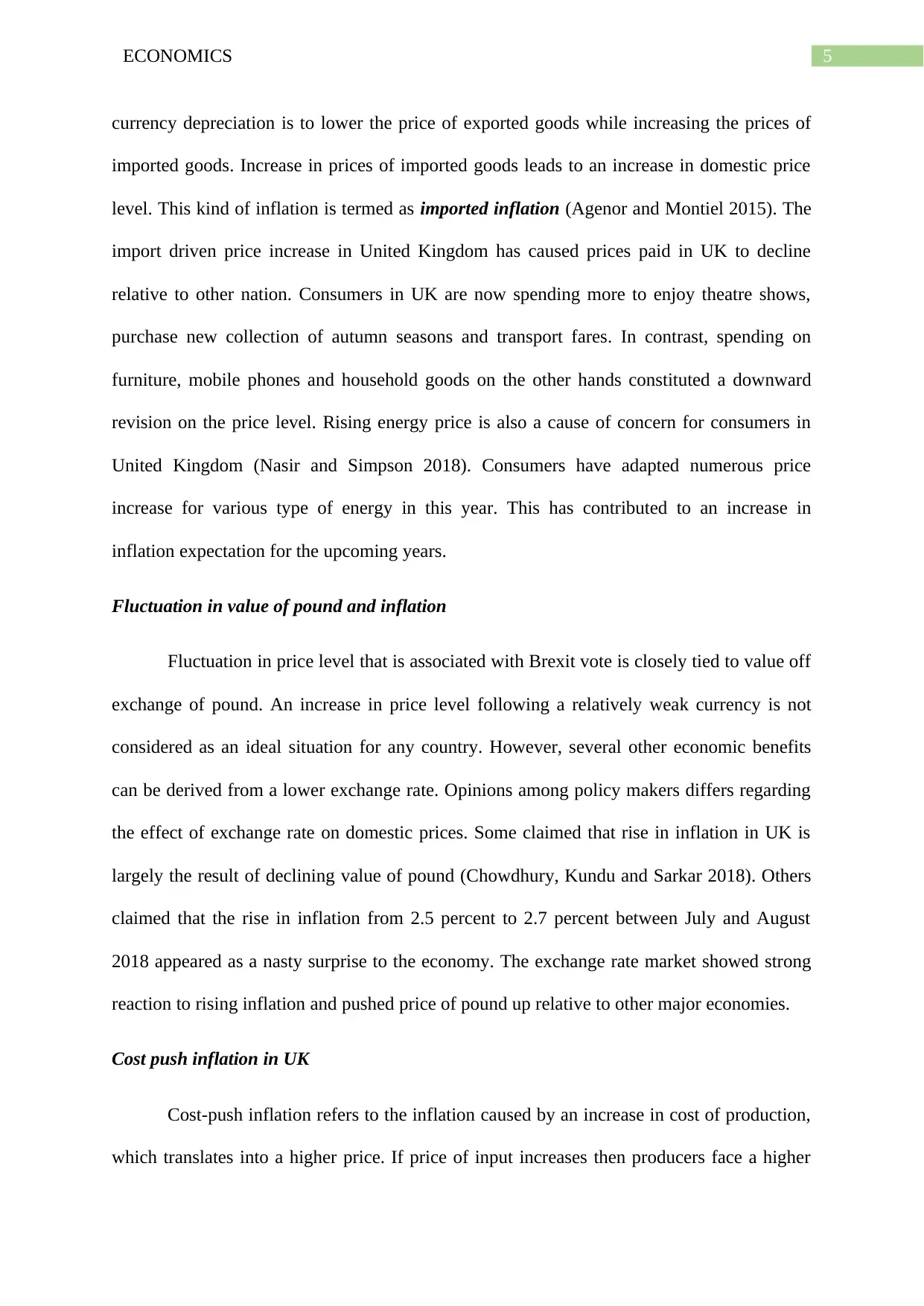
5ECONOMICS
currency depreciation is to lower the price of exported goods while increasing the prices of
imported goods. Increase in prices of imported goods leads to an increase in domestic price
level. This kind of inflation is termed as imported inflation (Agenor and Montiel 2015). The
import driven price increase in United Kingdom has caused prices paid in UK to decline
relative to other nation. Consumers in UK are now spending more to enjoy theatre shows,
purchase new collection of autumn seasons and transport fares. In contrast, spending on
furniture, mobile phones and household goods on the other hands constituted a downward
revision on the price level. Rising energy price is also a cause of concern for consumers in
United Kingdom (Nasir and Simpson 2018). Consumers have adapted numerous price
increase for various type of energy in this year. This has contributed to an increase in
inflation expectation for the upcoming years.
Fluctuation in value of pound and inflation
Fluctuation in price level that is associated with Brexit vote is closely tied to value off
exchange of pound. An increase in price level following a relatively weak currency is not
considered as an ideal situation for any country. However, several other economic benefits
can be derived from a lower exchange rate. Opinions among policy makers differs regarding
the effect of exchange rate on domestic prices. Some claimed that rise in inflation in UK is
largely the result of declining value of pound (Chowdhury, Kundu and Sarkar 2018). Others
claimed that the rise in inflation from 2.5 percent to 2.7 percent between July and August
2018 appeared as a nasty surprise to the economy. The exchange rate market showed strong
reaction to rising inflation and pushed price of pound up relative to other major economies.
Cost push inflation in UK
Cost-push inflation refers to the inflation caused by an increase in cost of production,
which translates into a higher price. If price of input increases then producers face a higher
currency depreciation is to lower the price of exported goods while increasing the prices of
imported goods. Increase in prices of imported goods leads to an increase in domestic price
level. This kind of inflation is termed as imported inflation (Agenor and Montiel 2015). The
import driven price increase in United Kingdom has caused prices paid in UK to decline
relative to other nation. Consumers in UK are now spending more to enjoy theatre shows,
purchase new collection of autumn seasons and transport fares. In contrast, spending on
furniture, mobile phones and household goods on the other hands constituted a downward
revision on the price level. Rising energy price is also a cause of concern for consumers in
United Kingdom (Nasir and Simpson 2018). Consumers have adapted numerous price
increase for various type of energy in this year. This has contributed to an increase in
inflation expectation for the upcoming years.
Fluctuation in value of pound and inflation
Fluctuation in price level that is associated with Brexit vote is closely tied to value off
exchange of pound. An increase in price level following a relatively weak currency is not
considered as an ideal situation for any country. However, several other economic benefits
can be derived from a lower exchange rate. Opinions among policy makers differs regarding
the effect of exchange rate on domestic prices. Some claimed that rise in inflation in UK is
largely the result of declining value of pound (Chowdhury, Kundu and Sarkar 2018). Others
claimed that the rise in inflation from 2.5 percent to 2.7 percent between July and August
2018 appeared as a nasty surprise to the economy. The exchange rate market showed strong
reaction to rising inflation and pushed price of pound up relative to other major economies.
Cost push inflation in UK
Cost-push inflation refers to the inflation caused by an increase in cost of production,
which translates into a higher price. If price of input increases then producers face a higher
⊘ This is a preview!⊘
Do you want full access?
Subscribe today to unlock all pages.

Trusted by 1+ million students worldwide

6ECONOMICS
production cost. In order to cur production cost, firms then contracts their production
resulting in a decline in aggregate supply (Brown and Narasimhan 2019). Given demand, the
supply shortage creates an upward pressure on price. This form of inflation is termed as cost-
push inflation. Increase in prices of any of vital inputs can cause cost-push inflation. Upward
pressure on several raw materials and oil prices have resulted in cost-push inflation adding
upward pressure to overall price level. The manufacturing sector in United Kingdom has
faced a considerable increase in the cost of raw materials. Cost of raw materials in July 2018
was increased by 10.9 percent. Rate of increases in raw material cost in 2018 exceeds the rate
in 2017. This marked the largest increase within a year. Rise in raw materials cost increases
cost of production in manufacturing sector and raises inflationary pressure. The biggest
contributor of rising cost pressure is the significant increase in oil prices. Oil price has
increased by more than 50 percent during this period. As oil is used one of crucial inputs in
different oil-dependent industries, there is a significant increase production cost causing
inflation in the economy.
Government policies to combat inflation
Monetary policy is used to maintain stability in the price level. In Unite Kingdom, it
is the responsibility of Bank of England to design monetary policy. The current inflation
target for BOE is 2 percent. Following an increase in inflation rate between July and August
2018, Bank of England raised the interest rate by 0.25 percentage point. As a result, bank rate
increased to 0.75 percent from 0.5 percent in the previous quarter (bbc.com 2018). By
increasing the interest rate, Bank of England expected to push down the inflation rate to the
targeted level.
Conclusion
production cost. In order to cur production cost, firms then contracts their production
resulting in a decline in aggregate supply (Brown and Narasimhan 2019). Given demand, the
supply shortage creates an upward pressure on price. This form of inflation is termed as cost-
push inflation. Increase in prices of any of vital inputs can cause cost-push inflation. Upward
pressure on several raw materials and oil prices have resulted in cost-push inflation adding
upward pressure to overall price level. The manufacturing sector in United Kingdom has
faced a considerable increase in the cost of raw materials. Cost of raw materials in July 2018
was increased by 10.9 percent. Rate of increases in raw material cost in 2018 exceeds the rate
in 2017. This marked the largest increase within a year. Rise in raw materials cost increases
cost of production in manufacturing sector and raises inflationary pressure. The biggest
contributor of rising cost pressure is the significant increase in oil prices. Oil price has
increased by more than 50 percent during this period. As oil is used one of crucial inputs in
different oil-dependent industries, there is a significant increase production cost causing
inflation in the economy.
Government policies to combat inflation
Monetary policy is used to maintain stability in the price level. In Unite Kingdom, it
is the responsibility of Bank of England to design monetary policy. The current inflation
target for BOE is 2 percent. Following an increase in inflation rate between July and August
2018, Bank of England raised the interest rate by 0.25 percentage point. As a result, bank rate
increased to 0.75 percent from 0.5 percent in the previous quarter (bbc.com 2018). By
increasing the interest rate, Bank of England expected to push down the inflation rate to the
targeted level.
Conclusion
Paraphrase This Document
Need a fresh take? Get an instant paraphrase of this document with our AI Paraphraser
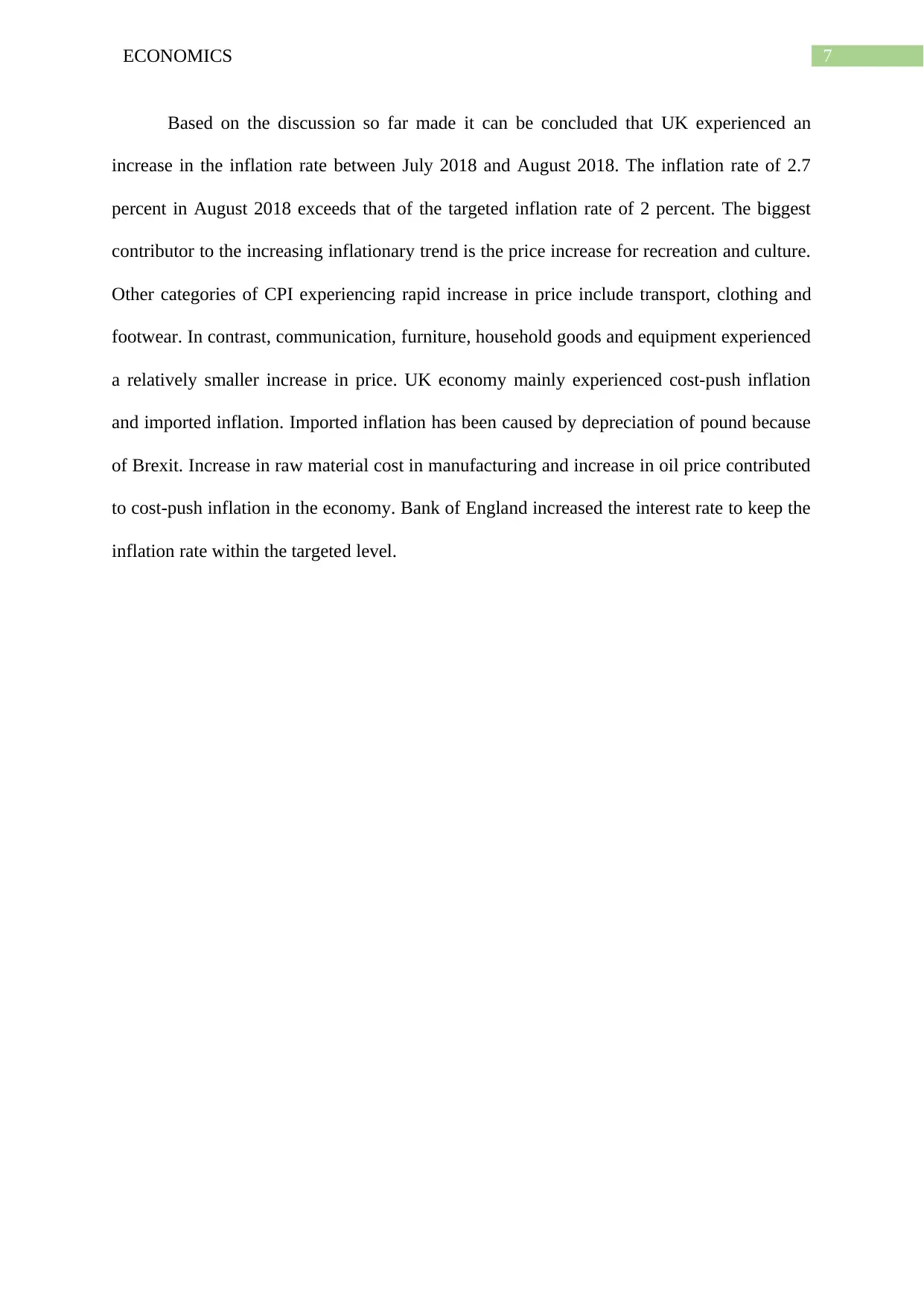
7ECONOMICS
Based on the discussion so far made it can be concluded that UK experienced an
increase in the inflation rate between July 2018 and August 2018. The inflation rate of 2.7
percent in August 2018 exceeds that of the targeted inflation rate of 2 percent. The biggest
contributor to the increasing inflationary trend is the price increase for recreation and culture.
Other categories of CPI experiencing rapid increase in price include transport, clothing and
footwear. In contrast, communication, furniture, household goods and equipment experienced
a relatively smaller increase in price. UK economy mainly experienced cost-push inflation
and imported inflation. Imported inflation has been caused by depreciation of pound because
of Brexit. Increase in raw material cost in manufacturing and increase in oil price contributed
to cost-push inflation in the economy. Bank of England increased the interest rate to keep the
inflation rate within the targeted level.
Based on the discussion so far made it can be concluded that UK experienced an
increase in the inflation rate between July 2018 and August 2018. The inflation rate of 2.7
percent in August 2018 exceeds that of the targeted inflation rate of 2 percent. The biggest
contributor to the increasing inflationary trend is the price increase for recreation and culture.
Other categories of CPI experiencing rapid increase in price include transport, clothing and
footwear. In contrast, communication, furniture, household goods and equipment experienced
a relatively smaller increase in price. UK economy mainly experienced cost-push inflation
and imported inflation. Imported inflation has been caused by depreciation of pound because
of Brexit. Increase in raw material cost in manufacturing and increase in oil price contributed
to cost-push inflation in the economy. Bank of England increased the interest rate to keep the
inflation rate within the targeted level.
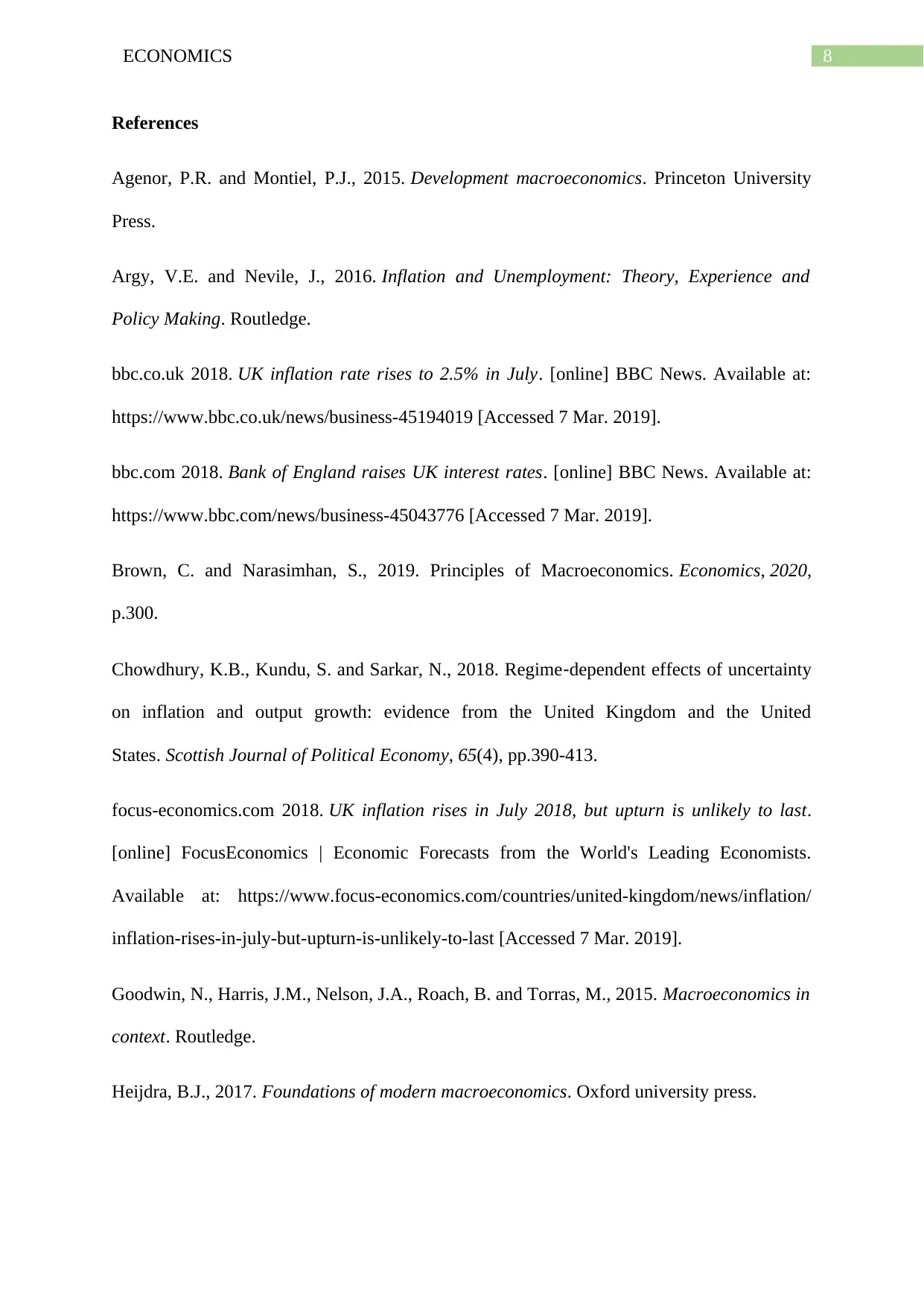
8ECONOMICS
References
Agenor, P.R. and Montiel, P.J., 2015. Development macroeconomics. Princeton University
Press.
Argy, V.E. and Nevile, J., 2016. Inflation and Unemployment: Theory, Experience and
Policy Making. Routledge.
bbc.co.uk 2018. UK inflation rate rises to 2.5% in July. [online] BBC News. Available at:
https://www.bbc.co.uk/news/business-45194019 [Accessed 7 Mar. 2019].
bbc.com 2018. Bank of England raises UK interest rates. [online] BBC News. Available at:
https://www.bbc.com/news/business-45043776 [Accessed 7 Mar. 2019].
Brown, C. and Narasimhan, S., 2019. Principles of Macroeconomics. Economics, 2020,
p.300.
Chowdhury, K.B., Kundu, S. and Sarkar, N., 2018. Regime‐dependent effects of uncertainty
on inflation and output growth: evidence from the United Kingdom and the United
States. Scottish Journal of Political Economy, 65(4), pp.390-413.
focus-economics.com 2018. UK inflation rises in July 2018, but upturn is unlikely to last.
[online] FocusEconomics | Economic Forecasts from the World's Leading Economists.
Available at: https://www.focus-economics.com/countries/united-kingdom/news/inflation/
inflation-rises-in-july-but-upturn-is-unlikely-to-last [Accessed 7 Mar. 2019].
Goodwin, N., Harris, J.M., Nelson, J.A., Roach, B. and Torras, M., 2015. Macroeconomics in
context. Routledge.
Heijdra, B.J., 2017. Foundations of modern macroeconomics. Oxford university press.
References
Agenor, P.R. and Montiel, P.J., 2015. Development macroeconomics. Princeton University
Press.
Argy, V.E. and Nevile, J., 2016. Inflation and Unemployment: Theory, Experience and
Policy Making. Routledge.
bbc.co.uk 2018. UK inflation rate rises to 2.5% in July. [online] BBC News. Available at:
https://www.bbc.co.uk/news/business-45194019 [Accessed 7 Mar. 2019].
bbc.com 2018. Bank of England raises UK interest rates. [online] BBC News. Available at:
https://www.bbc.com/news/business-45043776 [Accessed 7 Mar. 2019].
Brown, C. and Narasimhan, S., 2019. Principles of Macroeconomics. Economics, 2020,
p.300.
Chowdhury, K.B., Kundu, S. and Sarkar, N., 2018. Regime‐dependent effects of uncertainty
on inflation and output growth: evidence from the United Kingdom and the United
States. Scottish Journal of Political Economy, 65(4), pp.390-413.
focus-economics.com 2018. UK inflation rises in July 2018, but upturn is unlikely to last.
[online] FocusEconomics | Economic Forecasts from the World's Leading Economists.
Available at: https://www.focus-economics.com/countries/united-kingdom/news/inflation/
inflation-rises-in-july-but-upturn-is-unlikely-to-last [Accessed 7 Mar. 2019].
Goodwin, N., Harris, J.M., Nelson, J.A., Roach, B. and Torras, M., 2015. Macroeconomics in
context. Routledge.
Heijdra, B.J., 2017. Foundations of modern macroeconomics. Oxford university press.
⊘ This is a preview!⊘
Do you want full access?
Subscribe today to unlock all pages.

Trusted by 1+ million students worldwide
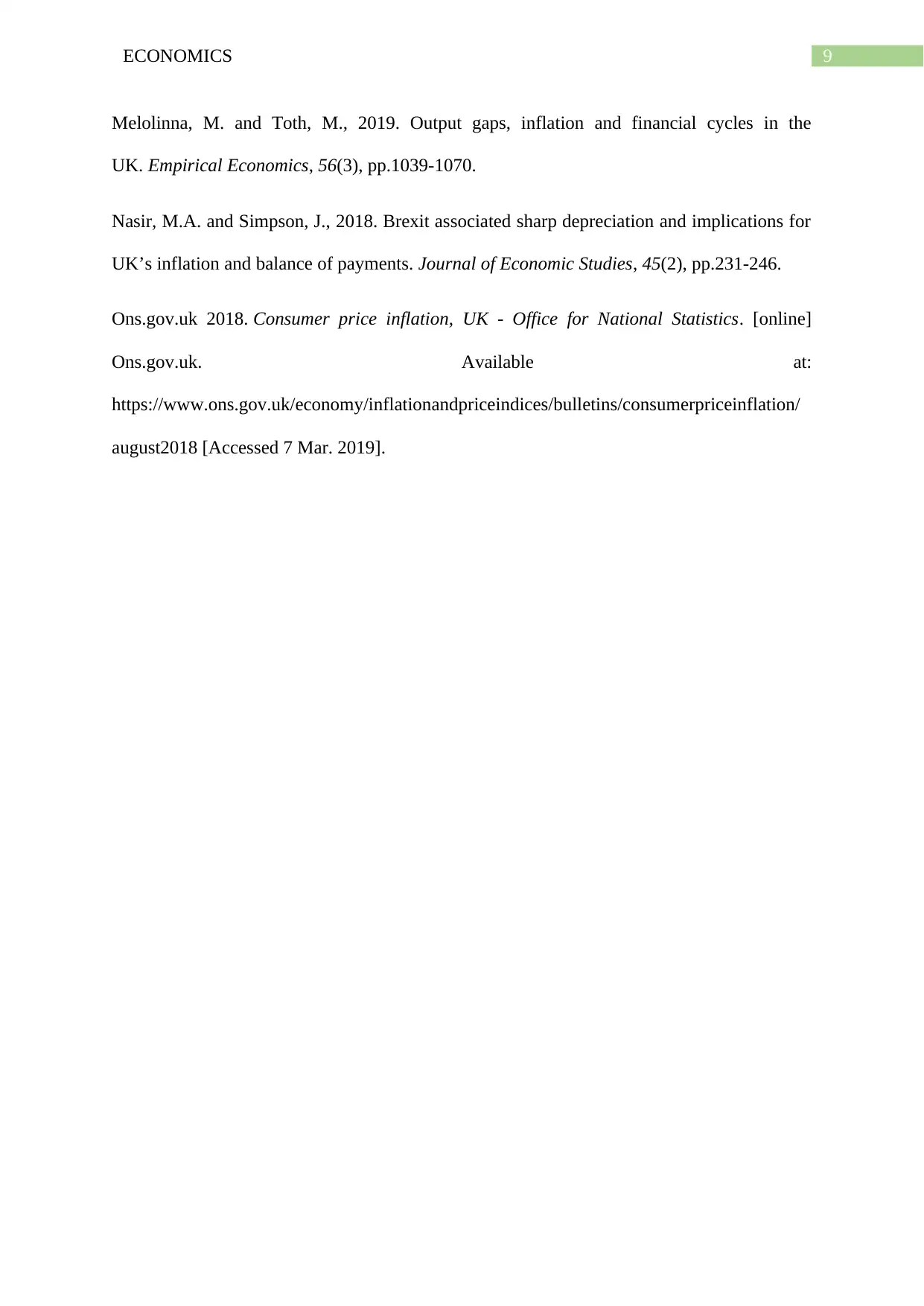
9ECONOMICS
Melolinna, M. and Toth, M., 2019. Output gaps, inflation and financial cycles in the
UK. Empirical Economics, 56(3), pp.1039-1070.
Nasir, M.A. and Simpson, J., 2018. Brexit associated sharp depreciation and implications for
UK’s inflation and balance of payments. Journal of Economic Studies, 45(2), pp.231-246.
Ons.gov.uk 2018. Consumer price inflation, UK - Office for National Statistics. [online]
Ons.gov.uk. Available at:
https://www.ons.gov.uk/economy/inflationandpriceindices/bulletins/consumerpriceinflation/
august2018 [Accessed 7 Mar. 2019].
Melolinna, M. and Toth, M., 2019. Output gaps, inflation and financial cycles in the
UK. Empirical Economics, 56(3), pp.1039-1070.
Nasir, M.A. and Simpson, J., 2018. Brexit associated sharp depreciation and implications for
UK’s inflation and balance of payments. Journal of Economic Studies, 45(2), pp.231-246.
Ons.gov.uk 2018. Consumer price inflation, UK - Office for National Statistics. [online]
Ons.gov.uk. Available at:
https://www.ons.gov.uk/economy/inflationandpriceindices/bulletins/consumerpriceinflation/
august2018 [Accessed 7 Mar. 2019].
1 out of 10
Related Documents
Your All-in-One AI-Powered Toolkit for Academic Success.
+13062052269
info@desklib.com
Available 24*7 on WhatsApp / Email
![[object Object]](/_next/static/media/star-bottom.7253800d.svg)
Unlock your academic potential
Copyright © 2020–2025 A2Z Services. All Rights Reserved. Developed and managed by ZUCOL.





